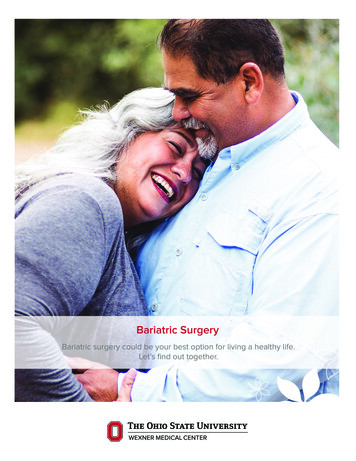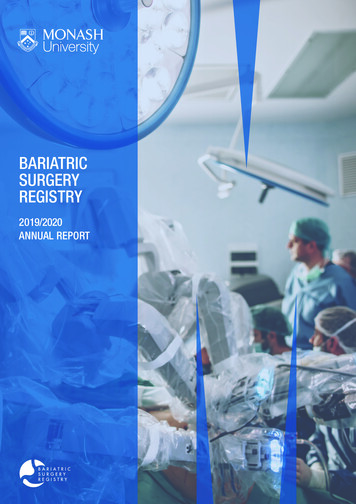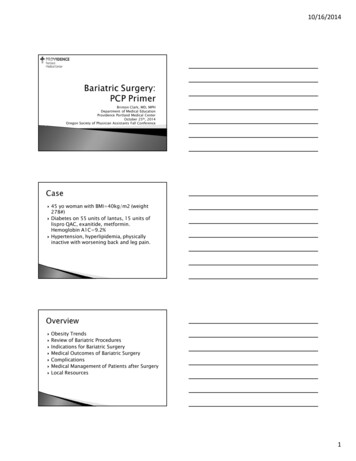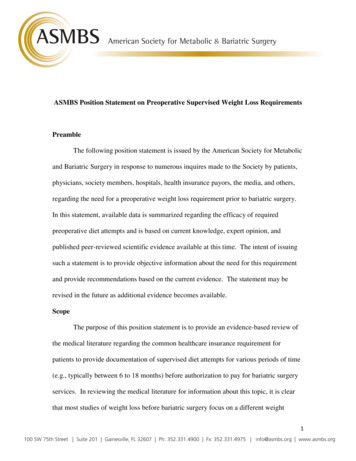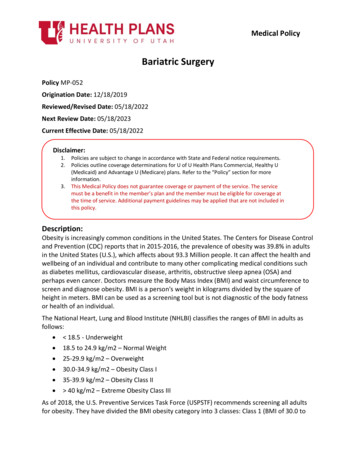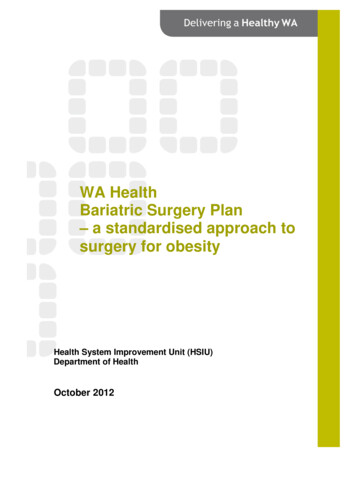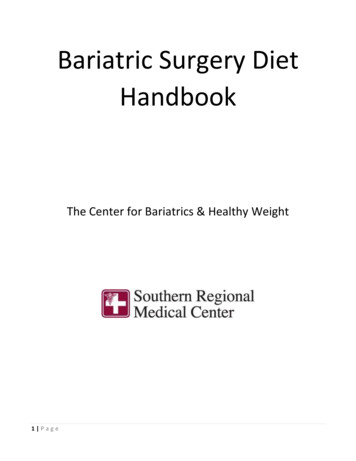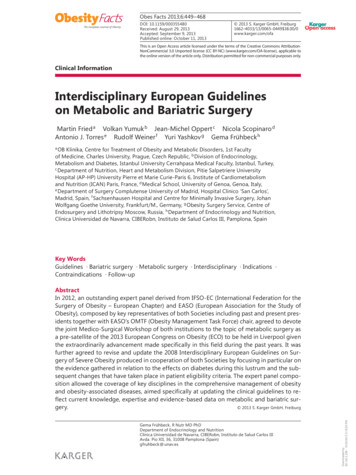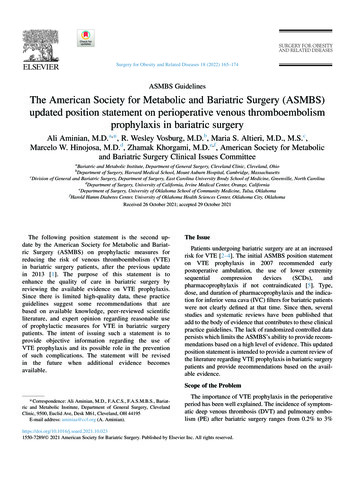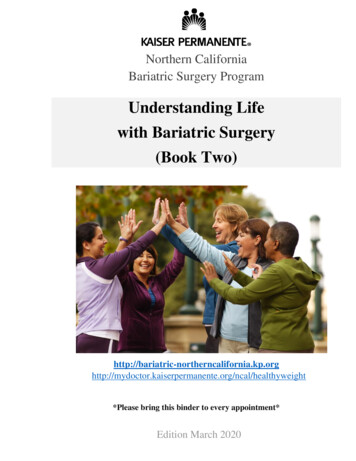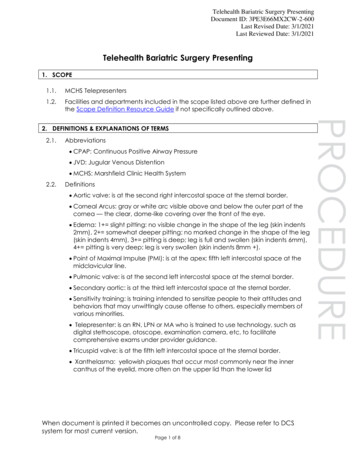
Transcription
Telehealth Bariatric Surgery PresentingDocument ID: 3PE3E66MX2CW-2-600Last Revised Date: 3/1/2021Last Reviewed Date: 3/1/2021Telehealth Bariatric Surgery Presenting1. SCOPE1.1.MCHS Telepresenters1.2.Facilities and departments included in the scope listed above are further defined inthe Scope Definition Resource Guide if not specifically outlined above.2. DEFINITIONS & EXPLANATIONS OF TERMS2.1.Abbreviations CPAP: Continuous Positive Airway Pressure JVD: Jugular Venous Distention MCHS: Marshfield Clinic Health System2.2.Definitions Aortic valve: is at the second right intercostal space at the sternal border. Corneal Arcus: gray or white arc visible above and below the outer part of thecornea — the clear, dome-like covering over the front of the eye. Edema: 1 slight pitting: no visible change in the shape of the leg (skin indents2mm), 2 somewhat deeper pitting; no marked change in the shape of the leg(skin indents 4mm), 3 pitting is deep; leg is full and swollen (skin indents 6mm),4 pitting is very deep; leg is very swollen (skin indents 8mm ). Point of Maximal Impulse (PMI): is at the apex; fifth left intercostal space at themidclavicular line. Pulmonic valve: is at the second left intercostal space at the sternal border. Secondary aortic: is at the third left intercostal space at the sternal border. Sensitivity training: is training intended to sensitize people to their attitudes andbehaviors that may unwittingly cause offense to others, especially members ofvarious minorities. Telepresenter: is an RN, LPN or MA who is trained to use technology, such asdigital stethoscope, otoscope, examination camera, etc, to facilitatecomprehensive exams under provider guidance. Tricuspid valve: is at the fifth left intercostal space at the sternal border. Xanthelasma: yellowish plaques that occur most commonly near the innercanthus of the eyelid, more often on the upper lid than the lower lidWhen document is printed it becomes an uncontrolled copy. Please refer to DCSsystem for most current version.Page 1 of 8
Telehealth Bariatric Surgery PresentingDocument ID: 3PE3E66MX2CW-2-600Last Revised Date: 3/1/2021Last Reviewed Date: 3/1/20213. PROCEDURE BODY3.1.Program Materialsa. Bariatric Information Session folders Updates are the responsibility of Bariatric Surgery. Bariatric Surgery sendsnew forms, content etc. for existing folders when necessary and updatedfolders as applicable. If low on folders, email staff at the Marshfield Center Bariatric SurgeryDepartment/Program for replacementsb. Bariatric Surgery Patient Handbooks (“patient binder”) are located in eachTelehealth exam room Give to the patient at the first bariatric Nurse Practitioner visit Updates to handbooks are the responsibility of Bariatric Surgery. BariatricSurgery will send new content etc. for existing handbooks when necessaryand updated handbooks as applicable. If low on handbooks email staff at the Marshfield Center Bariatric SurgeryDepartment/Program for replacements3.2.Pre-assessment physical exama. See Telehealth Core Presenting Vitals signs: Be sure to select the appropriate provider and the necessarypackage that coincides with the visit Height –without shoes Weight-without shoes BMI Blood Pressure Pulse Neck Circumference if first visit with General SurgeryMeasure in Inches Enter results in Dashboardb. The provider uses the STOP-BANG questionnaire to evaluate referral status onpatients without a known diagnosis of Obstructive Sleep Apnea & CPAPtherapy. The provider will ask questions about: Snoring Tiredness, Epworth Sleepiness Scale tool. Observed apneic events Pressure, High Blood PressureWhen document is printed it becomes an uncontrolled copy. Please refer to DCSsystem for most current version.Page 2 of 8
Telehealth Bariatric Surgery PresentingDocument ID: 3PE3E66MX2CW-2-600Last Revised Date: 3/1/2021Last Reviewed Date: 3/1/2021 If 2 of above criteria are met, sleep referral indicated. If less continue STOPBANG assessment. Body Mass Index / 35 Age 50 Neck circumference 15 3/4" Gender male If 3 or greater of 8 of above criteria are met refer to sleep medicine.3.3.Provider Directed Physical Exama. Neck Assess JVD. Distention reflects right arterial pressure, giving providers’ importantclinical indicator of cardiac function and right heart hemodynamics. JVD is evaluated best from the right internal jugular vein, because theright internal vein has a more direct anatomic channel into the rightatrium. Display patient sitting and lying with the room camera. First instruct the patient to sit upright at a 90-degree angle. Veins arenormally flat and pulsations are not evident. Then ask the patient to lie supine with the head slightly elevated 30-45degrees. Hyperextension or flexion may stretch or kink the vein. Apply moderately firm pressure with the palm of hand over the patient’sright upper abdominal quadrant for 30-60 seconds. If jugular venouspressure increases, the vein will appear more prominent.b. Eyes Using the hand held camera or room camera to zoom in on the eyesallowing the provider to assess the eyes for: Xanthelasma corneal arcus pale conjunctivae- associated with anemia cyanotic conjunctivae petechiae on conjunctivaeWhen document is printed it becomes an uncontrolled copy. Please refer to DCSsystem for most current version.Page 3 of 8
Telehealth Bariatric Surgery PresentingDocument ID: 3PE3E66MX2CW-2-600Last Revised Date: 3/1/2021Last Reviewed Date: 3/1/2021c. Heart With the patient’s anterior side to the room camera, apply limited pressureto the digital stethoscope to auscultate. Watch the provider for cues tomove to the next landmark. Aortic valve Pulmonic valve Tricuspid valve Mitral Valve/Point of Maximal Impulse (PMI)d. Lungs With the patient’s posterior side to the room camera, place limited pressurewith the digital stethoscope at the six posterior lung fields for two completeinspirations and expirations or until provider cues you to move to the nextlandmark. Begin with the upper lobes of the lung, moving the diaphragm of thestethoscope in a ladder-like pattern, from one side to the other. This will allow the provider to identify patterns of breath sounds andcompare symmetric areas of the lungs. Then with the patient’s anterior side facing the room camera, use thedigital stethoscope to auscultate two anterior lung fields. (If requested byprovider).e. Abdomen: AuscultationWhen document is printed it becomes an uncontrolled copy. Please refer to DCSsystem for most current version.Page 4 of 8
Telehealth Bariatric Surgery PresentingDocument ID: 3PE3E66MX2CW-2-600Last Revised Date: 3/1/2021Last Reviewed Date: 3/1/2021 Place patient in supine position place digital stethoscope on patient’sabdomen to assess bowel sounds Standing: provider needs to see umbilicus to assess for umbilical hernia Valsalva Maneuver:Patient is instructed to hold shirt up, hold breath, and pushnaval out Skin assessment of abdomen;Under breastsUnder pannus, in abdominal creases, but not perineum, leaveunderwear in place. Palpation of upper abdomen for discomfort (not organ size), on exam tableif able, can also be done with patient standing. When done with patient standing instruct patient to brace themselvesusing a staggered stance to prevent you from pushing them backwards Instruct patient to indicate if they experience any discomfort duringpalpation. Watch for non-verbal signs of discomfort e.g. patient pullsaway, facial expressions Location: Placement is between ribs and ileac crest, not too high andmid-umbilicus and sternum.Epigastric; gastric/duodenalLeft upper quadrant (LUQ); gastricRight Upper Quadrant (RUQ); gallbladder/liver Technique:Use flat part of hand or pads of fingers, not fingertips.Fingers should be together, avoid sudden jabs.Use light to deeper, but not aggressive pressure.Use upward rolling motion similar to performing HeimlichManeuver when applying pressureWhen document is printed it becomes an uncontrolled copy. Please refer to DCSsystem for most current version.Page 5 of 8
Telehealth Bariatric Surgery PresentingDocument ID: 3PE3E66MX2CW-2-600Last Revised Date: 3/1/2021Last Reviewed Date: 3/1/2021Patient focused exhalation may be necessary for an anxiouspatient.Provider will speak with patient and guide palpation.f. Legs Skin color Pitting edema assessment Telehealth presenter presses into patient’s shin area (on the tibia) Provider will need to see the leg to assess degree of severity, if any.g. Gait: Provider may ask, but if abnormal, report disability prior to visit onDashboard Provider Worksheet3.4.Post Physical Exam: See Telehealth Core Presenting Document3.5.Post Considerations: See Telehealth Core Presenting DocumentWhen document is printed it becomes an uncontrolled copy. Please refer to DCSsystem for most current version.Page 6 of 8
Telehealth Bariatric Surgery PresentingDocument ID: 3PE3E66MX2CW-2-600Last Revised Date: 3/1/2021Last Reviewed Date: 3/1/20214. ADDITIONAL RESOURCES4.1.References None4.2.Supporting documents available: Telehealth Core PresentingWhen document is printed it becomes an uncontrolled copy. Please refer to DCSsystem for most current version.Page 7 of 8
Telehealth Bariatric Surgery PresentingDocument ID: 3PE3E66MX2CW-2-600Last Revised Date: 3/1/2021Last Reviewed Date: 3/1/20215. DOCUMENT HISTORYVersion No.1.02.0Revision DescriptionNew DocumentModifications to document3.0Reviewed and fixed links 01/12/2018 by Sharon D, Telehealth ProjectCoordinator4.0Removed Marshfield Clinic Logo, Updated Quick Part in Header, Reformat ofSection 2.Updated Scope to include MCHS, Reformat of Section 2, Removed 3.3 a,updated new 3.3a (old 3.3b). Removed ACO Blood Pressure Screening Processfrom section 4.2.5.0Per Julianne Elsen, Removed existing 3.1 section regarding BariatricInformational Sessions as telehealth is no longer involved in facilitating those.Deleted Bariatric Surgery Questionnaire link and updated Telehealth CorePresenting link throughout document.When document is printed it becomes an uncontrolled copy. Please refer to DCSsystem for most current version.Page 8 of 8
Telehealth Bariatric Surgery Presenting Document ID: 3PE3E66MX2CW-2-600 Last Revised Date: 3/1/2021 . Removed Marshfield Clinic Logo, Updated Quick Part in Header, Reformat of Section 2. Updated Scope to include MCHS, Reformat of Section 2, Removed 3.3 a, updated new 3.3a (old 3.3b). Removed ACO Blood Pressure Screening Process
